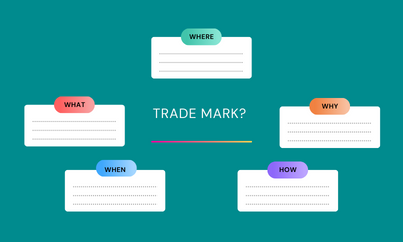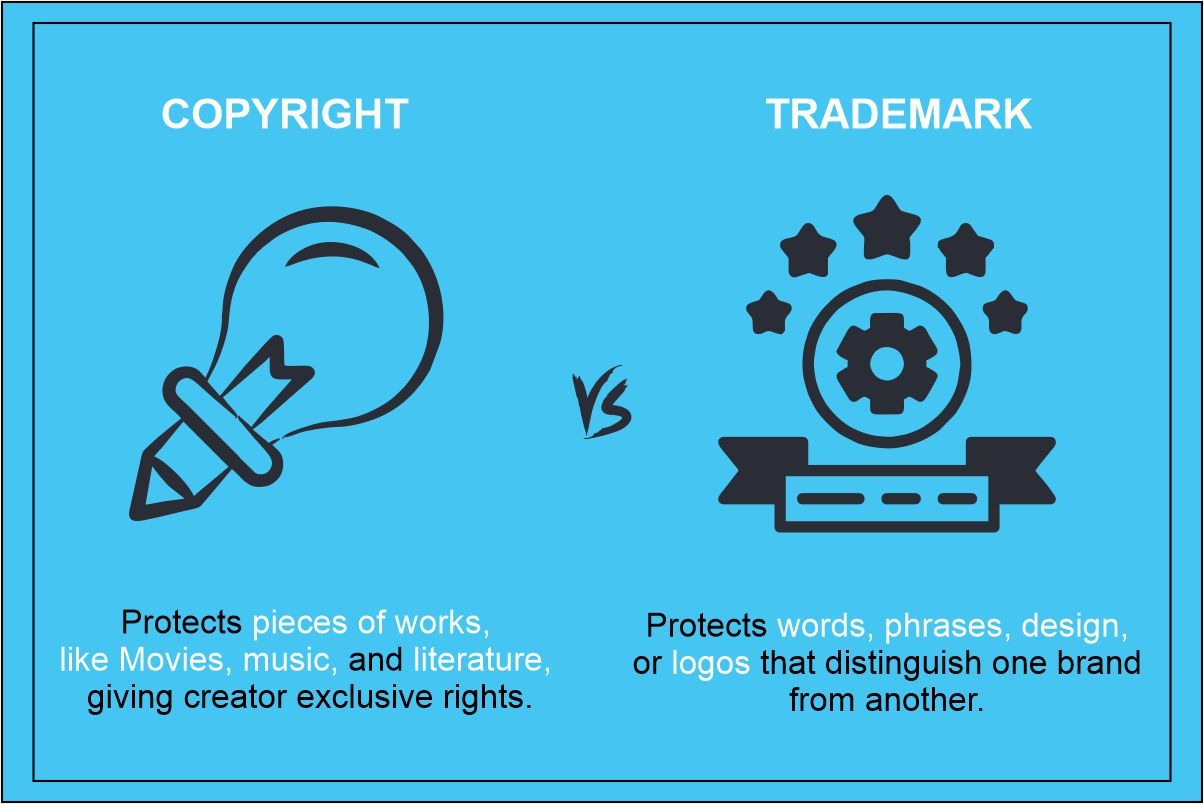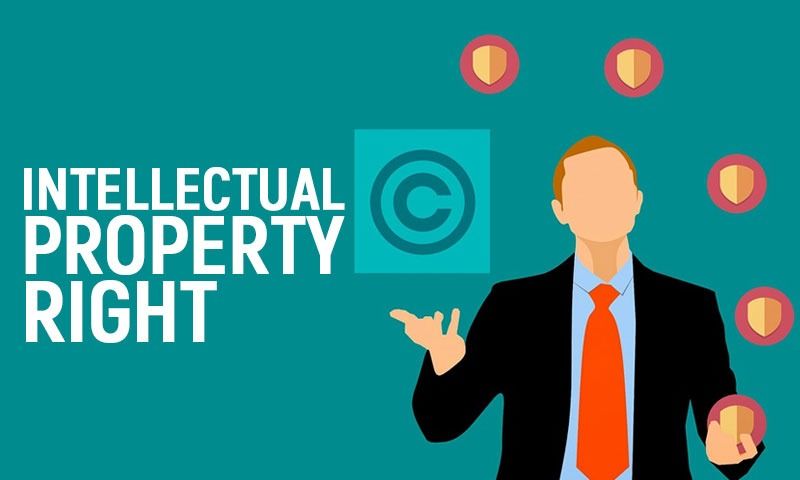The legal ownership of intangible assets, such as inventions, literary and artistic works, designs, symbols,…

What is TradeMark?
Introduction
For businesses to succeed in today’s market, they must have a distinct identity that distinguishes them from their rivals. Trademarks can be used in this situation.
Trademarks are a vital component of branding and are extremely important in identifying and safeguarding a company’s intellectual property.
The history, advantages, types, registration process, and other pertinent details of trademarks will all be covered in greater detail in this article.
How do trademarks work?
A trademark is a special image, pattern, word, or phrase that sets one company’s goods or services apart from another.
It is a type of intellectual property that grants the owner of the trademark exclusive rights. A trademark may take the form of a logo, a word or phrase, or both. It might also be a shape, sound, or fragrance.
What is a class in trademark?
A class in trademark law is a group of goods or services that a brand is used for. The Nice Classification system, which categorizes goods and services into 45 separate types, is the recognized international system for classifying trademarks.
The first 34 courses deal with products, and the latter 11 classes deal with services.
Businesses must identify the class or classes of products or services for which the trademark will be used when submitting a trademark application.
As you can see the process of submitting a trademark application.
This makes it possible to make sure the trademark is only registered for the specific products or services for which it will be used and that it does not infringe upon the rights of any already-registered trademarks belonging to the same class.
For instance, a company might submit an application for a trademark in Class 30, which includes coffee, tea, chocolate, and other food and beverage goods, if it wanted to register a trademark for a new brand of coffee.
It would be necessary to apply for a trademark in Class 21, which deals with domestic and kitchen utensils and containers if the company later wishes to grow and start selling coffee mugs and other accessories.
In conclusion, classes are a crucial component of trademark law because they ensure that trademarks are only registered for certain goods or services and that they do not clash with any already-registered trademarks in the same class.
Trademarks are categorized using the Nice Classification system based on the products or services they are used for.
The Nice Classification system has 45 different classes, with classes 1 to 34 covering products and classes 35 to 45 covering services. A summary of each class is provided below:
Chemicals and pharmaceuticals are covered under Classes 1–5, including industrial chemicals, fertilizers, and drugs for human and veterinary use.
Classes 6 to 20 cover a range of products derived from metals and metal alloys, such as common metals, tools, and building supplies.
Classes 21 to 29 cover a variety of machinery and appliances, including both electric and non-electric household appliances, as well as automobiles.
Food and beverage goods, such as coffee, tea, chocolate, and many kinds of prepared dishes, are covered in classes 30-34.
Services of all kinds, including advertising, company management, insurance, and education, are covered in classes 35–45.
A more thorough description of each class is given below:
Class 1: Chemicals for use in business, science, and photography; unprocessed plastics; manures; fire extinguishing compositions; tempering and soldering preparations; and chemicals for food preservation are all included.
Class 2: Metals in foil and powder form for painters, decorators, printers, and artists. Preservatives against rust and against the deterioration of wood. Colorants. Mordants. Raw natural resins.
Class 3 includes soaps, perfumes, essential oils, cosmetics, hair lotions, and dentifrices. It also includes bleaching solutions and other laundry-related products.
Class 4 includes lubricants, dust-absorbing, wetting, and binding substances, as well as industrial oils and greases, fuels (including motor spirit), illuminants, candles, and wicks.
Class 5: Pharmaceutical and veterinary preparations; sanitary preparations for medical purposes; dietetic food and substances adapted for medical or veterinary use; Food for infants; plasters, materials for dressings; materials for stopping teeth, dental wax; disinfectants; preparations for destroying vermin; fungicides, herbicides.
Class 6 includes common metals and their alloys, transportable metal buildings, materials for railroad tracks, non-electric cables and wires, ironmongery, small metal hardware items, pipes and tubes, safes, and common metal products not covered by other classes.
Class 7 includes machines and machine tools, motors and engines (apart from those used in land vehicles), machine coupling and transmission parts, other than hand-operated agricultural implements, and egg incubators.
Class 8 includes cutlery, side weapons, razors, and hand tools and implements (hand-operated).
Class 9: Scientific, nautical, surveying, photographic, cinematographic, optical, weighing, measuring, signaling, checking (supervision), life-saving, and teaching apparatus and instruments; apparatus and instruments for conducting, switching, transforming, accumulating, regulating, or controlling electricity; apparatus for recording, transmission or reproduction of sound or images; magnetic data carriers, recording discs; compact discs, DVDs and other digital recording media; mechanisms for coin-operated apparatus; cash registers, calculating machines, data processing equipment, computers; fire-extinguishing apparatus.
Class 10: Surgical, medical, dental, and veterinary apparatus and instruments, artificial limbs, eyes, and teeth; orthopedic articles; suture materials.
Class 11: Apparatus for lighting, heating, steam generating, cooking, refrigerating, drying, ventilating, water supply, and sanitary
Class 12: Vehicles – This class contains both vehicles and the components that go with them, such as the brakes, tyres, and engines for cars, motorbikes, and bicycles.
Class 13: This all included Guns, ammunition, and explosives (firearms and explosives).
Class 14: Jewelry and Watches – This category contains precious metals and stones, as well as jewelry, watches, and other timepieces.
Class 15: Musical instruments, such as pianos, guitars, and drum sets.
Class 16: Paper Products and Printed Matter – Paper products like books, newspapers, periodicals, and stationery are included in this category.
Class 17: Tires, hoses, belts, and other rubber goods.
Class 18: Leather Products – This category covers items made of leather, including belts, wallets, and bags.
Class 19: Construction materials classified as non-metallic, such as bricks, tiles, and asphalt.
Class 20: Furniture and Home Items – This category contains household items like mirrors and kitchen utensils as well as furniture like chairs, tables, and mattresses.
Class 21: Kitchen and Household Utensils, Cooking utensils, glassware, and other domestic products.
Class 22: Ropes and Cordage, twine, and other cordage.
Class 23: Yarns and threads—which are used for textiles.
Class 24: Fabrics – Textiles including clothing, beds, and curtains are included in this category.
Class 25: Apparel, such as shirts, slacks, and dresses.
Class 26: Lace, embroidery, and other decorative textiles – (lace and embroidery).
Class 27: Carpets, rugs, and other flooring components fall – Carpets and Rugs.
Class 28: Toys, games, and sporting – Toys and Sporting Products.
Class 29: Meat, fish, and other processed foods – Meats and Processed Foods.
Class 30: Staple foods, like bread, cereal, and pasta.
Class 31: Agricultural and Natural Goods – This class covers foods like grains, fruits, and vegetables that are both agricultural and natural.
Class 32: Non-alcoholic beverages, such as juice and soda.
Class 33: Alcoholic Drinks – Included in this category are alcoholic drinks like beer, wine, and spirits.
Class 34: Tobacco goods, including cigarettes, cigars, and chewing tobacco.
Class 35: Services in marketing, management, and administration
Services linked to marketing, promoting, and advertising goods and services are included in class 35, as are managerial and administrative services for businesses.
Services in this category include office tasks, outsourcing, commercial information and guidance for consumers, business management and organization consulting, advertising, and marketing research, and sales promotion for others.
Class 36: Financial and insurance services
Services pertaining to insurance and financial problems are covered by Class 36. This covers products and services such as underwriting insurance, financial analysis, money management, banking, real estate management, and fundraising for charities.
Class 37: Construction and building services
Building and construction-related services, as well as repair and installation services, are included in Class 37.
Construction, repair, installation, and maintenance services for buildings, roads, bridges, and other infrastructure are included in this class.
Class 38: Services related to communications
Telecommunications-related services, such as the transmission of speech, data, pictures, and messages via electronic media, are included in Class 38.
This category includes services like electronic mail, telecommunications links, and communication via computer terminals.
Class 39: Services for storage and transportation
Services involved in the storage and transportation of commodities are under Class 39. This category includes services like cargo transportation, packaging, and storage, as well as services for making travel arrangements.
Class 40: Services for treating materials
Services pertaining to the treatment of materials are covered by Class 40. This comprises products and services like bespoke manufacturing, material treatment, waste and rubbish recycling, and information on material treatment.
Class 41: Instructional and recreational services
Services pertaining to education, recreation, sports, and cultural events are included in class 41. This category includes services like instruction and training, the planning of cultural or educational exhibitions, and entertainment services like sporting and cultural events.
Class 42: Services in science and technology
Services relating to technological and scientific research and development, as well as the design and development of computer hardware and software, are included in class 42.
Services in this category include those related to scientific research and development, computer hardware and software design and development, and computer programming.
Class 43: Meals and catering
Services linked to supplying food and beverages for consumption are included in class 43. This category includes services including food and beverage distribution, catering, and hotel services.
Service Type 44: Veterinary and medical
Services linked to human and animal veterinary health are covered by class 44. Services including veterinary and medical care, hygienic and cosmetic services for people and animals, and services related to agriculture, horticulture, and forestry fall under this category.
Class 43: Meals and catering
Services linked to supplying food and beverages for consumption are included in class 43. This category includes services including food and beverage distribution, catering, and hotel services.
Service Type 44: Veterinary and medical
Services linked to human and animal veterinary health are covered by class 44. Services including veterinary and medical care, hygienic and cosmetic services for people and animals, and services related to agriculture, horticulture, and forestry fall under this category.
Class 45: Security and legal services
Services relating to law and security are included in class 45. This category includes services provided by others to meet people’s needs, including legal services, security services to safeguard people and property, and personal and social services.
The Nice Classification offers a structure for classifying trademarks according to the categories of goods and services they cover.
To guarantee that their brand is registered in the proper class and is given the necessary protection, trademark owners and applicants must have a thorough understanding of the various classes of trademarks.
What does a trademark protect?
A trademark safeguards a business’s brand identification and aids in separating its goods or services from those of its rivals.
A trademark specifically defends any combination of these elements—words, names, symbols, designs—used to identify and set one company’s products or services apart from those of another.
A business that registers a trademark is granted the only authority to employ that mark in connection with the products or services listed in the registration.
This means that third parties are prohibited from using a mark that is confusingly similar to yours in connection with products or services that are comparable to yours. If a trademark is used without permission, the owner of the mark may file a lawsuit to prevent it and seek damages for any injury it may have caused.
Additionally, customers benefit from trademark protection since it makes it simple for them to recognize and select goods and services that they are acquainted with and trust.
For instance, customers may trust the quality of a product when they see the Nike “swoosh” mark on a pair of sneakers since they know the shoes are manufactured by Nike.
Ultimately, a trademark is an important tool for protecting a company’s goods or services from unlawful use by other parties and can help a business establish and uphold its brand identity and reputation.
How to get a Trademark?
A few actions must be taken in order to obtain a trademark. Here is a general description of what happens:
- Be sure the mark you intend to use is not already being used by another company by conducting a trademark search before submitting an application. You can do this by looking up relevant terms in the USPTO database or by employing a trademark lawyer to carry out a more in-depth search.
- Once you’ve established that your chosen trademark is available, you must submit a trademark application to the USPTO. The application should contain details on the mark, the products or services it will be used with, and your contact information. It can be submitted online or by mail.
- A trademark examiner will review your application after it is submitted to ensure that it satisfies all conditions for registration. The examiner will send you an office action describing any concerns with the application and offering you a chance to rectify them if there are any.
- Publication: If the examiner approves your application, it will be published in the USPTO’s Official Gazette. This allows other parties the opportunity to contest your registration if they think it would violate their own trademark rights.
- Release of trademark registration: You will be issued a certificate of registration for your trademark if no one objects to it during the opposition period or if any objections are overruled.
It’s important to keep in mind that the process of establishing a trademark may be challenging and drawn out, so it’s a good idea to engage with a trademark lawyer to guide you through it and make sure your trademark is protected.
FOR MORE DETAILS CONTACT US
How to register a trademark in India?
A. Determine whether a trademark is available.
To make sure the proposed trademark is eligible for registration, a search must be done as the first stage in the trademark registration procedure. On the Trademark Registry’s website, this can be done online.
B. Application for a Trademark
The applicant may submit the trademark application either online or offline when the trademark’s availability has been verified. The following information should be included in the application:
- Name and address of the applicant
- Description of the goods or services for which the trademark is sought
- Image of the trademark
- Details of any priority claim (if applicable)
C. Application for a Trademark is examined
The Trademark Registrar reviews the trademark application after it has been filed. If the application does not satisfy the qualifying requirements, the Registrar may raise objections.
D. Trademark Application Publication
The Trademark Journal publishes the trademark application if it is approved. The publication is made in order to elicit resistance to trademark registration.
E. Disputes in Opposition
Within four months of the trademark application’s publication, any person or organization that opposes the registration of the trademark may file such an opposition.
F. The filing of a trademark.
if no opposition is presented or if it is rejected,
A certificate of registration is issued after the trademark is registered. The registration is good for ten years after the filing date and may be renewed for additional ten-year periods.
How to check a trademark?
Trademark Search
To determine if a proposed trademark is eligible for registration, a trademark search is carried out. The search aids in identifying any existing trademarks that are identical to or confusingly similar to the proposed trademark in order to prevent the registration application from being denied.
Indian Trademark Search Process
Doing a trademark search in India entails the following steps:
A. Go to the website of the Trademark Registry.
The first step is to go to the Trademark Registry’s website, which is run by the Indian Ministry of Commerce and Industry.
B. Visit the Trademark Search Website
To access the trademark search portal, click the “Trademark” button on the website’s home page and then the “Public Search” link.
C. Provide the Trademark Information
Enter the proposed trademark’s data, including the class of products or services, the proposed trademark name, and the type of search, into the trademark search portal (i.e., wordmark, device mark, or phonetic search).
D. Start Search
Click the “Search” button to start the search after entering the necessary information. All of the existing trademarks that are identical to or confusingly similar to the proposed trademark will be included in the search results that are displayed on the portal.
D. Look through the search results
If you want to be sure the proposed trademark is eligible for registration, carefully review the search results. Before starting the registration procedure, it is advisable to consult a trademark lawyer whether there are any existing trademarks that are confusingly similar to the proposed property.
IV. Conclusion
A crucial step in the trademark registration procedure that helps to ascertain the availability of the proposed trademark is conducting a trademark search.
An easy and effective way to search for trademarks is using the Trademark Registry of India’s trademark search web.
If there are any questions or concerns regarding the availability of the proposed trademark, it is advisable to consult a trademark lawyer.
CALL US FOR MORE DETAILS
How to get a trademark certificate
A trademark application is eligible for objection for four months after it has been authorized and published in the Trademark Journal.
The trademark will be registered and a trademark certificate will be granted if no opposition is lodged during this time or if the opposition is rejected.
We will go over how to get a trademark certificate in India in this article.
- A trademark certificate is issued.
A trademark certificate will be given by the Trademark Registrar and the trademark will be registered if no opposition is lodged during the opposition period or if the opposition is rejected.
- Acquiring a trademark certificate
The applicant or a designated representative can obtain the trademark certificate from the Trademark Registry by making a written request and sending it along with the required paperwork, such as a power of attorney and identification evidence.
Conclusion
In India, obtaining a trademark certificate entails submitting a trademark application, having it reviewed, having it published in the Trademark Journal, and having the Trademark Registrar issue the certificate.
It is crucial to check that the trademark application satisfies the criteria for registration and to react quickly to any objections or oppositions put forth by the Trademark Registrar or other parties.
FAQs
Q1. How much does it cost to get a trademark in India?
Ans. Starting will be 5799/-. It depends upon the class of the individual to know more about charges you can visit https://registermytrade.com/trade-mark/
Q2. What is a trademark registration government website?
Ans. https://ipindia.gov.in/ is the government website you can register on by yourself.
Q 3. How to check trademark status?
Ans. Login to https://ipindiaonline.gov.in/eregister/eregister.aspx to check your trademark status.
Q4. Is trademark registration compulsory in e-commerce?
Ans. No trademark is not compulsory for e-commerce.
Q5. Why is trademark registration important for small businesses?
Ans. It Important because it allows customers to identify a business as the source of a product or service. TradeMark represents the brand identity because customers trusts the brand identity.




This Post Has 0 Comments